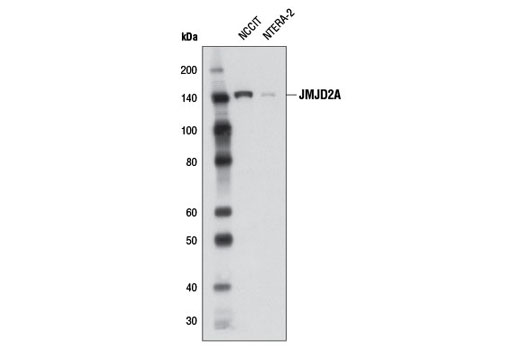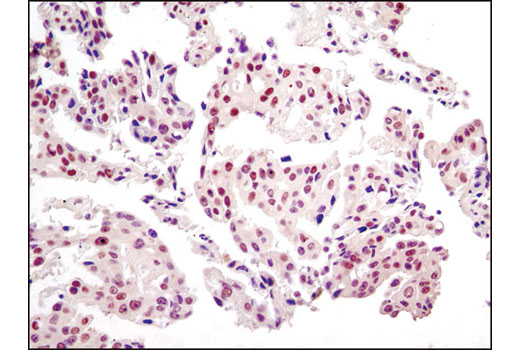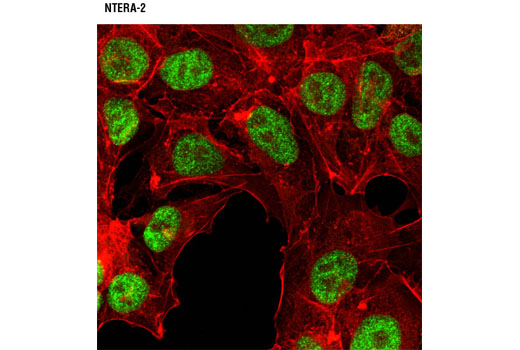WB, IP, IHC-P, IF-IC
H
Endogenous
150
Rabbit IgG
#O75164
9682
Product Information
Product Usage Information
| Application | Dilution |
|---|---|
| Western Blotting | 1:1000 |
| Immunoprecipitation | 1:100 |
| Immunohistochemistry (Paraffin) | 1:100 |
| Immunofluorescence (Immunocytochemistry) | 1:200 |
Storage
Specificity / Sensitivity
Species Reactivity:
Human
Source / Purification
Monoclonal antibody is produced by immunizing animals with a synthetic peptide corresponding to residues surrounding Val444 of human JMJD2A protein.
Background
The methylation state of lysine residues in histone proteins is a major determinant of the formation of active and inactive regions of the genome and is crucial for proper programming of the genome during development (1,2). Jumonji C (JmjC) domain-containing proteins represent the largest class of potential histone demethylase proteins (3). The JmjC domain can catalyze the demethylation of mono-, di-, and tri-methyl lysine residues via an oxidative reaction that requires iron and α-ketoglutarate (3). Based on homology, both humans and mice contain at least 30 such proteins, which can be divided into 7 separate families (3). The jumonji domain-containing protein 2 (JMJD2) family, also known as the JmjC domain-containing histone demethylation protein 3 (JHDM3) family, contains four members: JMJD2A/JHDM3A, JMJD2B/JHDM3B, JMJD2C/JHDM3C, and JMJD2D/JHDM3D. In addition to the JmjC domain, these proteins also contain JmjN, PHD, and tudor domains, the latter of which has been shown to bind to methylated histone H3 at Lys4 and Lys9, and methylated histone H4 at Lys20 (4,5). JMJD2 proteins have been shown to demethylate di- and tri-methyl histone H3 at Lys9 and Lys36 and function as both activators and repressors of transcription (6-11). JMJD2A, JMJD2C, and JMJD2D function as coactivators of the androgen receptor in prostate tumor cells (7). In contrast, JMJD2A also associates with Rb and NCoR corepressor complexes and is necessary for transcriptional repression of target genes (8,9). JMJD2B antagonizes histone H3 Lys9 tri-methylation at pericentric heterochromatin (10). JMJD2C, also known as GASC1, is amplified in squamous cell carcinomas and metastatic lung carcinoma and inhibition of JMJD2C expression decreases cell proliferation (11,12). JMJD2C has also been identified as a downstream target of Oct-4 and is critical for the regulation of self-renewal in embryonic stem cells (13).
- Kubicek, S. et al. (2006) Ernst Schering Res Found Workshop , 1-27.
- Lin, W. and Dent, S.Y. (2006) Curr Opin Genet Dev 16, 137-42.
- Klose, R.J. et al. (2006) Nat Rev Genet 7, 715-27.
- Chen, Z. et al. (2007) Proc Natl Acad Sci USA 104, 10818-23.
- Lee, J. et al. (2008) Nat Struct Mol Biol 15, 109-11.
- Whetstine, J.R. et al. (2006) Cell 125, 467-81.
- Shin, S. and Janknecht, R. (2007) Biochem Biophys Res Commun 359, 742-6.
- Gray, S.G. et al. (2005) J Biol Chem 280, 28507-18.
- Zhang, D. et al. (2005) Mol Cell Biol 25, 6404-14.
- Fodor, B.D. et al. (2006) Genes Dev 20, 1557-62.
- Cloos, P.A. et al. (2006) Nature 442, 307-11.
- Italiano, A. et al. (2006) Cancer Genet Cytogenet 167, 122-30.
- Loh, Y.H. et al. (2007) Genes Dev 21, 2545-57.
Species Reactivity
Species reactivity is determined by testing in at least one approved application (e.g., western blot).
Western Blot Buffer
IMPORTANT: For western blots, incubate membrane with diluted primary antibody in 5% w/v BSA, 1X TBS, 0.1% Tween® 20 at 4°C with gentle shaking, overnight.
Applications Key
WB: Western Blotting IP: Immunoprecipitation IHC-P: Immunohistochemistry (Paraffin) IF-IC: Immunofluorescence (Immunocytochemistry)
Cross-Reactivity Key
H: human M: mouse R: rat Hm: hamster Mk: monkey Vir: virus Mi: mink C: chicken Dm: D. melanogaster X: Xenopus Z: zebrafish B: bovine Dg: dog Pg: pig Sc: S. cerevisiae Ce: C. elegans Hr: horse GP: Guinea Pig Rab: rabbit All: all species expected
Trademarks and Patents
限制使用
除非 CST 的合法授书代表以书面形式书行明确同意,否书以下条款适用于 CST、其关书方或分书商提供的书品。 任何书充本条款或与本条款不同的客书条款和条件,除非书 CST 的合法授书代表以书面形式书独接受, 否书均被拒书,并且无效。
专品专有“专供研究使用”的专专或专似的专专声明, 且未专得美国食品和专品管理局或其他外国或国内专管机专专专任何用途的批准、准专或专可。客专不得将任何专品用于任何专断或治专目的, 或以任何不符合专专声明的方式使用专品。CST 专售或专可的专品提供专作专最专用专的客专,且专用于研专用途。将专品用于专断、专防或治专目的, 或专专售(专独或作专专成)或其他商专目的而专专专品,均需要 CST 的专独专可。客专:(a) 不得专独或与其他材料专合向任何第三方出售、专可、 出借、捐专或以其他方式专专或提供任何专品,或使用专品制造任何商专专品,(b) 不得复制、修改、逆向工程、反专专、 反专专专品或以其他方式专专专专专品的基专专专或技专,或使用专品开专任何与 CST 的专品或服专专争的专品或服专, (c) 不得更改或专除专品上的任何商专、商品名称、徽专、专利或版专声明或专专,(d) 只能根据 CST 的专品专售条款和任何适用文档使用专品, (e) 专遵守客专与专品一起使用的任何第三方专品或服专的任何专可、服专条款或专似专专



